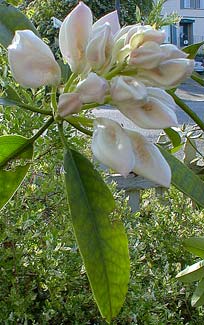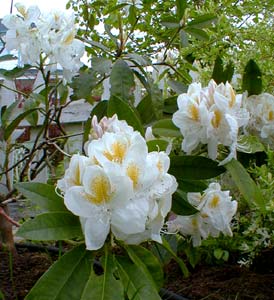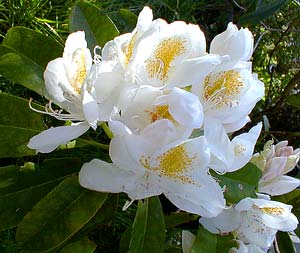 'Catawba Album'
'Catawba Album'
a classic Ironclad Rhododendron
"Shed no tear - O, shed no tear!
The flower will bloom another year.
Weep no more - O, weep no more!
Young buds sleep in the root's white core."
-John Keats
(1795-1821)
(1795-1821)
Rhododendron cawtawbiense var. album is a naturally occurring variant of the species rhododendron native to the Appalachian Mountains, but R. cawtabiense 'Album,' aka 'Catawba Album,' is the classic Ironclad bred in 1886 by one of the most famous of all early hybridizers, Englishman Anthony Waterer.
Anthony Waterer of Knap Hill in Surrey was the first English rhododendron hybridizer, having begun in 1830 when he crossed R. arboreum with R. caucasicum. Earlier work was begun in 1825 by Petrus Mortier, a baker of Ghent, who used his baker's oven to change the seasonal awareness of certain Rhododendron species, so that he could cross late-blooming azaleas to early bloomers. Mortier's work continued for decades, as did that of Anthony Waterer & his son John, who at Knap Hill used the Ghent hybrids as part of their development of increasingly hardy & flowery hybrids, many of which have remained garden standards to this day.
 The trusses can often have a dozen or eighteen trumpet flowers apiece, forming a complete ball. The leaves are slightly convex like upside-down spoons, so that leaf-chomping insects fall off the slippery shiny foliage without a bite. It has a rather open habit though careful pruning might make it more compact. I encourage the airiness of ours, because the twisting wide-reaching limbs are themselves so very pretty, & light reaches the ground to support a selection of perennials, such as a clump of Chocolate Cosmos at the sunlit edge, & a hardy geranium underneath.
The trusses can often have a dozen or eighteen trumpet flowers apiece, forming a complete ball. The leaves are slightly convex like upside-down spoons, so that leaf-chomping insects fall off the slippery shiny foliage without a bite. It has a rather open habit though careful pruning might make it more compact. I encourage the airiness of ours, because the twisting wide-reaching limbs are themselves so very pretty, & light reaches the ground to support a selection of perennials, such as a clump of Chocolate Cosmos at the sunlit edge, & a hardy geranium underneath.R. catawbiense grows wild as far north as New England. It is one of the hardiest of wild rhodies, & it was used to infuse hardiness in many more delicate species. There's good reason that among these early hybrids, 'Catawba Album' has remained popular for over a century. It remains one of the best whites ever developed.
For most gardeners, the Ironclads are regarded as classics. To a minority, a taste for Ironclads is considered plebian. Yet these old varieties are so reliable in their ease of growth & so extreme in their beauty, no collection of rhodies would be complete without at least a couple of Ironclads, even if one's tastes leaned toward rarer varieties too.
Too many Ironcalds in one spot are often too similar both in their blooming time & large-leaf appearance. So it is always best to break up any array of Ironclads with more novel species-rhodies, small evergreen azaleas & evergreem lepidote rhodies, large deciduous azaleas, as well as woody shrubs of entirely different genuses, especially ones that bloom later in the year or have autumn berries after spring blossoming.
 Although the generally hardy nature of Ironclads renders them often very tolerant of high sun exposures, they are nevertheless understory shrubs at heart, & grow to look their best near or under trees in dappled sunlight. When in full sun for years on end, they frequently trundle along healthily enough, but do not develop quite so pleasingly as when apportioned some shade. 'Catawba Album' more than most Ironclads would prefer dappled sunlight.
Although the generally hardy nature of Ironclads renders them often very tolerant of high sun exposures, they are nevertheless understory shrubs at heart, & grow to look their best near or under trees in dappled sunlight. When in full sun for years on end, they frequently trundle along healthily enough, but do not develop quite so pleasingly as when apportioned some shade. 'Catawba Album' more than most Ironclads would prefer dappled sunlight.Our 'Catawba Album' is four or five feet tall & six or seven feet wide, with open structure. It's an old shrub obtained when a friend bought a house that had been intensely gardened for forty years, & he wanted a half-dozen shrubs removed to make room for garden parties.
It now grows in our yard in the shade of cherry tree, with a couple of its lightning-zigzagging limbs reaching down a mild slope to embrace the lower trunk of the cherry. It is part of an array of shrubs that includes among other shrubs Nishiki Willow the fresh pink leaves of which make it look to be in bloom even when it is not, a Box Hebe with white veronica-like flowers later in the season, a mature semi-dwarf lepidote R. yungningense with lavender blooms in April ahead of 'Catawba Album,' & the burgundy-black-leafed Diablo Ninebark that begins blooming before the 'Catawba Album' is completely done.
With this variety, there is something exciting happening in that corner of the gardens in every season, including winter with the Hebe & Rhododendrons being evergreen, & the Nishiki having bright red winter twigs, & the Diablo's exfoliating bark.
For more photographs of this shrub, go to the:
'Catawba Album' Page of the Rhododendron Gallery